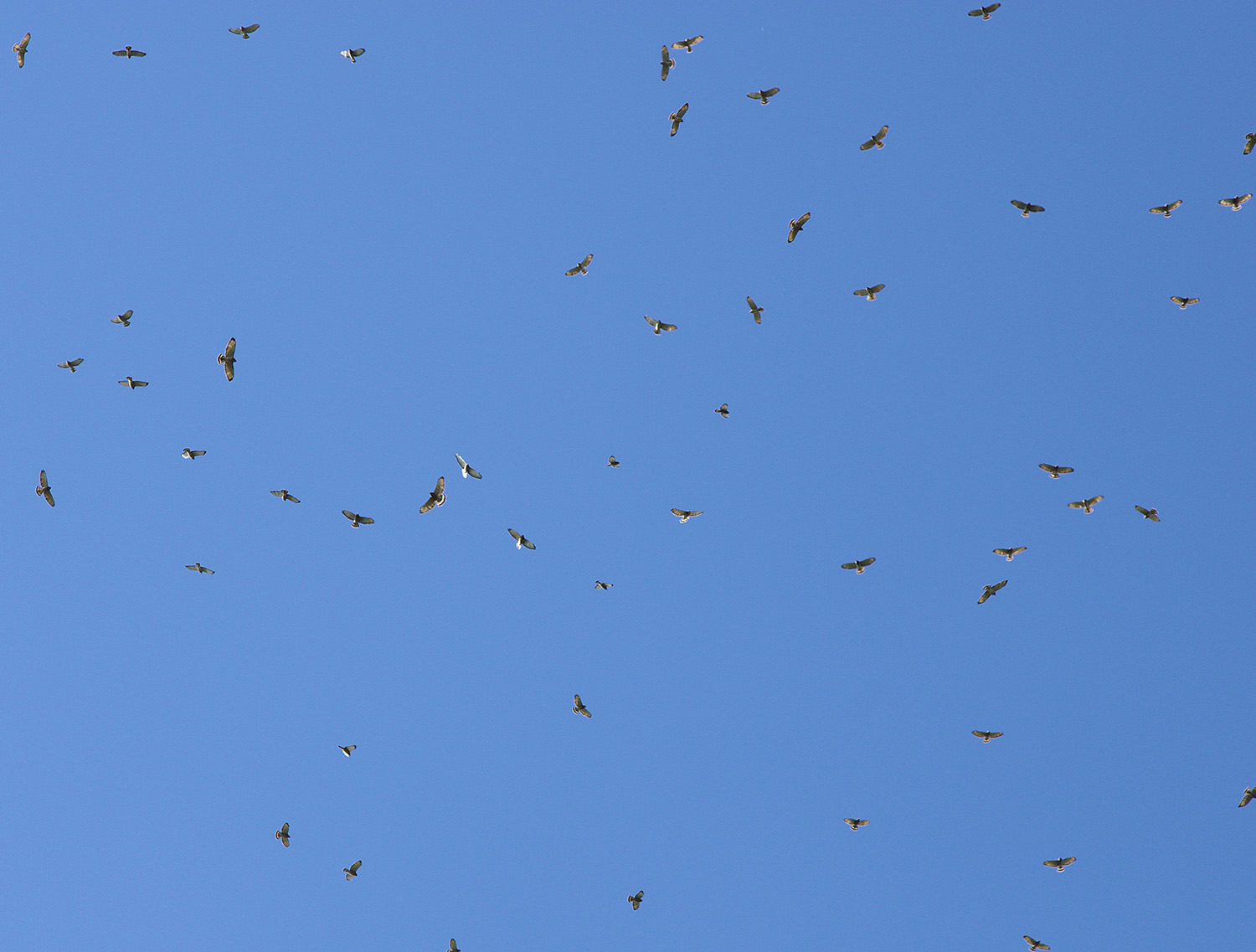Counting Hawks

A broad-winged hawk, Buteo platypterus, perches on a power line in Butler County, Ohio. Photo by Andrew Cannizzaro.
By Ray Zimmerman
As summer ends, the broad-winged hawks gather for their migration. Eastern hawkwatchers count their numbers at observation points along the length of the Appalachian Mountains. The hawks arrive at Soddy Mountain near Chattanooga, Tennessee, from points as far north as New England and Canada. The oldest of the observation points is Hawk Mountain in Kempton, Pennsylvania, active since 1936.
Before becoming an observation site, Hawk Mountain was a site of hawk slaughter. Gunners came to shoot coopers and sharp-shinned hawks but most especially goshawks, according to the Hawk Mountain Sanctuary Association, which manages the refuge. These three species are part of a group collectively known as accipiters, which hunters called “chicken hawks.” The state of Pennsylvania paid a bounty for goshawks and the gunners believed the hawks ate poultry. With education, people began looking forward to the arrival of accipiters and this motivated early hawk watches.
Many hawk watchers have since focused on the broad-winged hawk migration because of the large numbers of this species. Broad-winged hawks are the smallest hawk in a group known as “buteos.” Other commonly seen buteos include the red-tailed hawk and the red-shouldered hawk. In the Southern Appalachians, the broad-winged hawk flights predictably arrive around the third week of September.
By recording the number of hawks flying over a given point year after year, and their dates of arrival, the observers establish baseline data, which can be indicators of population shifts and environmental changes. An ornithologist researching the lives of red-tailed hawks, for example, could find out how their flight behavior and demographics have changed over the years.
Soddy Mountain
Bill Haley has been counting the migrating hawks from Soddy Mountain since 1993 and says he will continue for as long as he is able. He persists because “any day you see a hawk is a good day,” and he knows what is possible on any given day.
He related a story of a couple who drove hours from western Alabama to help with the hawk watch on September 19 and 20 of 2020. They saw about 100 broad-winged hawks on the first day and returned to a mountain enveloped in fog the following day.
Haley encouraged them to remain because lifting fog sometimes gives way to great hawk watching. Then the broad-winged hawks arrived. Haley described the flight as “a river of hawks 15 birds wide and as far back as I could see.” They counted 2,800 hawks in five minutes, and he told the volunteers, “Now you know what is possible.” By the end of that day, they had counted 4,066 hawks.
Haley says he counted 4,467 broad-winged hawks in 2020. Had he missed that one day, his numbers would have been quite different for the year.
Missed days are less frequent for Haley now that he has retired from his job as an educator at the Tennessee Aquarium. In 2020, he was present for at least part of 66 days and logged 341.5 hours counting birds of prey between September 16 and December 2. He observed 14 species.
Hawk watchers frequently arrive at the overlook and may spend hours waiting for a sighting without spotting anything before a flight arrives. This factor, along with the need for meticulous record keeping, may have prompted Haley’s remark that “hawk counts are not for everyone.”
Haley cautions those who would count raptors to get acquainted with resident birds. Several bald eagles and red-tailed hawks reside year-round in his region. They should not be counted as part of the migration. He and his volunteers are careful to learn the resident birds early and count only migrating birds, those flying south.
In the early years of his hawk watching, Haley served as the Southern Appalachian coordinator for the Hawk Migration Association of North America, a group that compiles information from roughly 200 hawk count sites across the continent and into Central America. He remains an active member of that organization, tabulating his data on their standard form.
Jimmy and Cynthia Wilkerson, two longtime volunteers, helped count birds at the Soddy Mountain Hawk Watch for several years, but now focus on reporting the data. Cynthia Wilkerson keeps a blog of the daily sightings and end-of-season totals for fall and spring. Jimmy Wilkerson records the numbers in the Hawk Migration Association of North America’s database.
This database includes participating hawk watch sites such as Big Bald on the Tennessee-North Carolina state line, Grandfather Mountain in North Carolina, and Rockfish Gap in Virginia. These are but a few of the many participating hawk watches along the Appalachians.
The broad-winged hawks follow this migration path before taking a more southwesterly track into Texas and then on to Central and South America. Several years ago, Haley spent part of one winter in Costa Rica and recalls seeing broad-winged hawks there. He pointed out a need for watchers to document the flights between the Chattanooga area and Texas.
Over his 27 years of hawk watching, Haley has seen one goshawk, a bird that is a rarity for Tennessee. He has noticed a steady increase in the number of bald eagles, which he attributes to recovery from the effects of poisoning by DDT and other persistent pesticides.
He has also noticed that the southward flights of red-tailed hawks arrive later in the year due to warmer winters further north. The red-tailed hawk migration is determined by weather and availability of prey species.
Haley stated that 25 volunteers helped count hawks at Soddy Mountain in 2020. The number of volunteers has increased as he has promoted the opportunity. More are welcome.

Two volunteers are stationed for a day of hawk watching at Soddy Mountain along the Cumberland Escarpment in Hamilton County, Tennessee. Photo by Bill Haley
Big Bald
The Blue Ridge Bird Observatory, formerly known as Southern Appalachian Raptor Research, operates the Big Bald Banding Station and the hawk count at Big Bald, a mountain on the border of North Carolina and Tennessee. The observatory has held the hawk count since 2004.
According to Mark Hopey of the Blue Ridge Bird Observatory, Big Bald is not easy to reach. Visitors must access the site using private roads and it is difficult to gain permission. Some hikers pass through on the Appalachian Trail. Big Bald is a six-mile walk from the nearest Appalachian Trail entry point. The iconic trail ascends the peak at 5,516 feet above sea level.
The hawk watch site and raptor banding station is in a well-protected, high location with excellent views within the Pisgah National Forest. Public lands provide habitat significant to the survival, stability and recovery of the hawks and several other species.
The grassy area atop Big Bald is good hunting for birds of prey with an abundance of small mammals resulting from the edge habitat where grasslands meet nearby forests. Some hawks may rest a while and hunt before moving on. Stopovers are important for the survival of these birds.
At 5,000 feet, the researchers on Big Bald can see the Blue Ridge Parkway and Grandfather Mountain but cannot see the birds visiting those locations. It can be a windy place, and the winds push migrating raptors into the area. Thermals are abundant in the surrounding valleys.
Many species of large raptors rely on thermals during migration. This is why they migrate over land. Air close to the ground heats up and the raptors spiral upward in groups called kettles. As each bird reaches the maximum height they can achieve in this way, they peel away and fly on, losing altitude until they reach the next thermal.
Observers might see 10, 200 or 10,000 birds on a given day depending on the weather. The hawk watchers track several weather factors from wind speed and precipitation to barometric pressure.
Data collected at Big Bald Hawk Watch is shared with the Hawk Migration Association of North America through their website.
The observers also watch the reports from stations further north, particularly Rockfish Gap and Hawk Mountain. Reports from those stations indicate that the hawks are moving south. The birds they count in the following days are not necessarily the same birds counted further north.
The number of sightings at Big Bald is increasing for peregrine falcons, as well as for bald and golden eagles. Turkey vultures and sharp-shinned hawks appear in large numbers, but broad-winged hawks are the most common. Big Bald is a key stopover for migrating birds of prey and its banding station and the hawk watch contribute important information to the hawk association’s data.

A kettle of broad-winged hawks soars above Grandfather Mountain during a previous Hawk Watch. In 2015, 10,615 broad-winged hawks were officially counted from atop Grandfather’s Linville Peak. Photo by Jesse Pope | Grandfather Mountain Stewardship Foundation
Grandfather Mountain
John Caveny, natural resource management specialist at Grandfather Mountain Stewardship Foundation, has been counting the hawks at this landmark peak in North Carolina’s High Country for eight years. Grandfather Mountain has been an official hawk watch site since 2008, although hawk counts and hawk watching had already taken place there for several years. From 5,303 feet, a lot is visible.
“The annual hawk migration is my favorite time of year; counting hawks is my favorite thing to do,” Caveny says. “When people learn about it and start looking up, they see it. The hawk watch migration has always gone on overhead, but they hadn’t noticed it. It is an aha moment for the visitors and a great tool to spread the conservation message.”
According to Caveny, the migrating raptors stick to the spine of the Appalachian mountains because of the thermals, updrafts of warm air that carry them aloft. Turkey vultures are perhaps the most noticeable of the birds who utilize these thermals, circling upward and then moving off, one by one, to the next thermal. Caveny said that he watches for circling turkey vultures to learn the location of the thermals on a given day and then watches those locations for migrating hawks.

Volunteer Monty Combs counts hawks from atop Linville Peak during Hawk Watch at Grandfather Mountain. Binoculars, scopes and cameras aid in viewing the migrating raptors, but most birds are visible with the naked eye. Photo courtesy of the Grandfather Mountain Stewardship Foundation
He also looks for multiple weather factors, any of which could affect the migration, and monitors the migration activity at Rockfish Gap in Waynesboro, Virginia. If Rockfish Gap observers see a large number of migrant raptors on one day, he can expect many raptors to pass over Grandfather Mountain on the following day — weather permitting.
As with most other hawk-watching sites, the broad-winged hawk is the most common migrating raptor spotted on Grandfather Mountain. In 2020, staff and volunteers counted more than 4,000. They saw 9,714 on September 23, 2015. Broad-winged hawks arrive in the highest numbers in the last half of September, often in the third week.
Numbers of bald eagles are increasing at Grandfather Mountain, and there is a nesting pair nearby. Caveny says he has seen the number of bald eagles rise from 12 migrants in September 2012 to 72 migrants in September 2020.
Rockfish Gap
Rockfish Gap in Virginia’s Blue Ridge Mountains has the largest flight of broad-winged hawks on the Atlantic Flyway, with 29,661 counted in fall 2020. Most of the broad-winged hawks arrive during the third week of September and the all-volunteer cadre of counters records their passage.
Those birds are joined by an even larger number of broad-winged hawks from the Mississippi Flyway when they reach Texas and Mexico, where all North American flyways for land birds converge in a flight into Central and South America.
Counting at Rockfish Gap is not limited to the third week of September, though. Counters begin their efforts on August 15 and continue through Nov. 30. The arrival of other raptors such as ospreys, falcons, bald eagles and sharp-shinned hawks is spread out through those months. In 2020, volunteers at Rockfish Gap spotted 2,100 sharp-shinned hawks.
Victor Laubach coordinates the count and encourages visitors to come and look for birds. He emphasizes the accessibility of the 2,000-foot-high hawk watch. Visitors can drive right to the location and can even look for hawks from their cars. They will, however, need binoculars, and several find spotting scopes helpful since the birds are not at eye level. Be prepared to look up when counting hawks at Rockfish Gap.
Visibility is great to the north, east and west at Rockfish Gap but not to the south, so the volunteers do not conduct a spring count. On foggy days, they may move to an alternate site in Waynesboro, Virginia, a lower site not shrouded in fog. The count continues, and fog may clear at Rockfish Gap within an hour or two.

A Cooper’s hawk circles above the volunteer hawk counters at Rockfish Gap in Virginia. Photo courtesy of Victor Laubach.
Fog is only one weather factor that impacts the count. Laubach is quick to point out that “everything depends on the weather.” Every site has its favorite wind, but northwest winds give the best days at Rockfish Gap.
Just as hawk watchers further south look at data from Rockfish Gap to forecast their counts for the coming days, Laubach looks to sites further north, such as Waggoner Gap in Pennsylvania, and even sites in New England to tell him when the hawks might arrive.
He says that the hawks may change their flight path east or west due to weather, but broad-winged hawks move when they are ready to move, despite the weather. Weather affects the count and their path, but they keep moving.
Laubach is concerned for the future of the Rockfish Gap hawk count. The current location is the Inn at Afton’s parking lot. This site works well and the owner is a gracious host, but the inn has been closed since 2019. In bygone days, people would stay at the inn and count hawks from their balconies. Eventually, the site will give way to development, and future owners will have their own plans for the property.
The number of hawk watchers helping with the count is also declining. New volunteers are welcome and needed to continue the tradition of this important hawk count.
Get Involved
To find a hawk count near you, go to hawkcount.org and click on the words “Find a Hawkwatch” in the left column. Scroll all the way down for a list of states and click on your state’s name for a list of hawkwatch sites.
Click on the link for any of the listed watches and look for contact information. It is wise to contact the site for further information, such as accessibility and best times to visit. Many sites are happy to accept volunteers. Pages for the individual sites will look much like this one for Grandfather Mountain.
Look Up
According to the Hawk Mountain Sanctuary Association, the spring migration is spread through the month of April and into May. The broad-winged hawk is a complete migrant, and they all leave their northern breeding grounds to spend the winter in Central and South America, so they all must return in the spring. Most other raptors are incomplete migrants, with migrating birds passing through the territories of resident birds.
Wherever you are in Appalachia, you are not far from migrating hawks. Look up in spring and fall, and you may see a migration. Better yet, visit one of the hawk-watch sites. People visit hawk watches and observatories for a variety of reasons. Some come just to see the magnificent birds in flight. Some find joy in the more scientific aspects of counting hawks and recording data that will be useful for researchers for generations to come.
Related Articles
Latest News
More Stories

Leave a comment
Your email address will not be published. Required fields are marked *



![“[There are] still a lot of individuals who need support, especially here in Green Cove, Whitetop, Konnarock — those are the communities up on the mountain,” says Little. “We were a part of Damascus, but because we are on the mountain outside of Damascus, a lot of the resources and help have not made their way here.” Photo by Jimmy Davidson.](https://appvoices.org/wp-content/uploads/2025/07/Virginia_Creeper_Trail_JMDavidson-32-1024x768.jpg)

